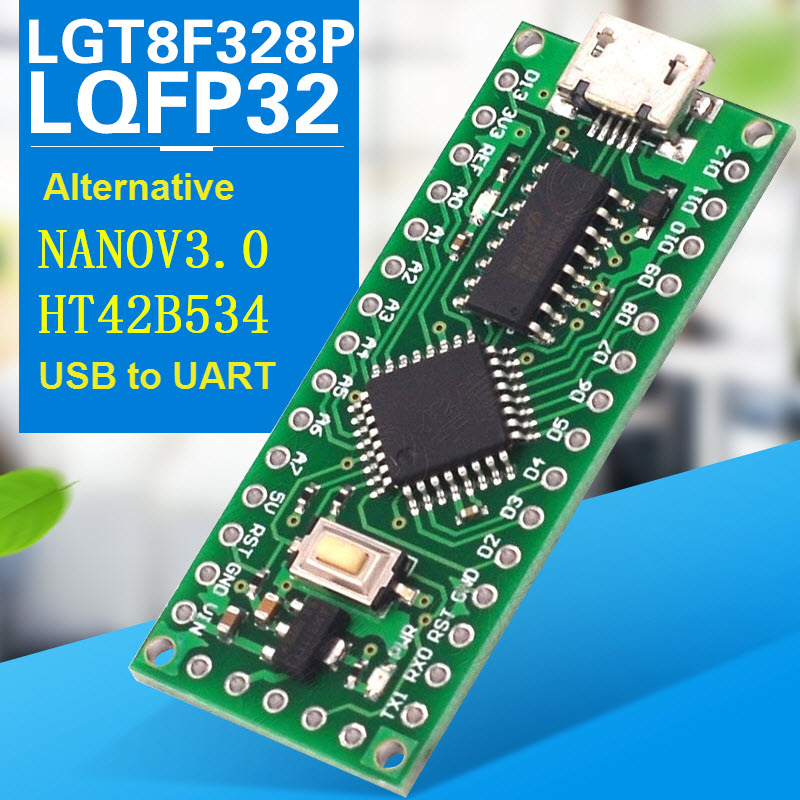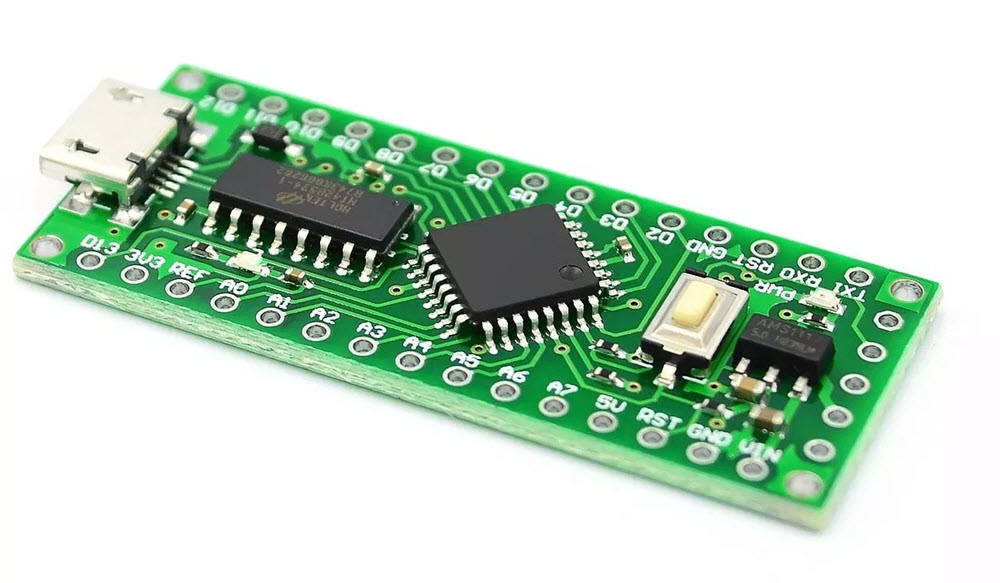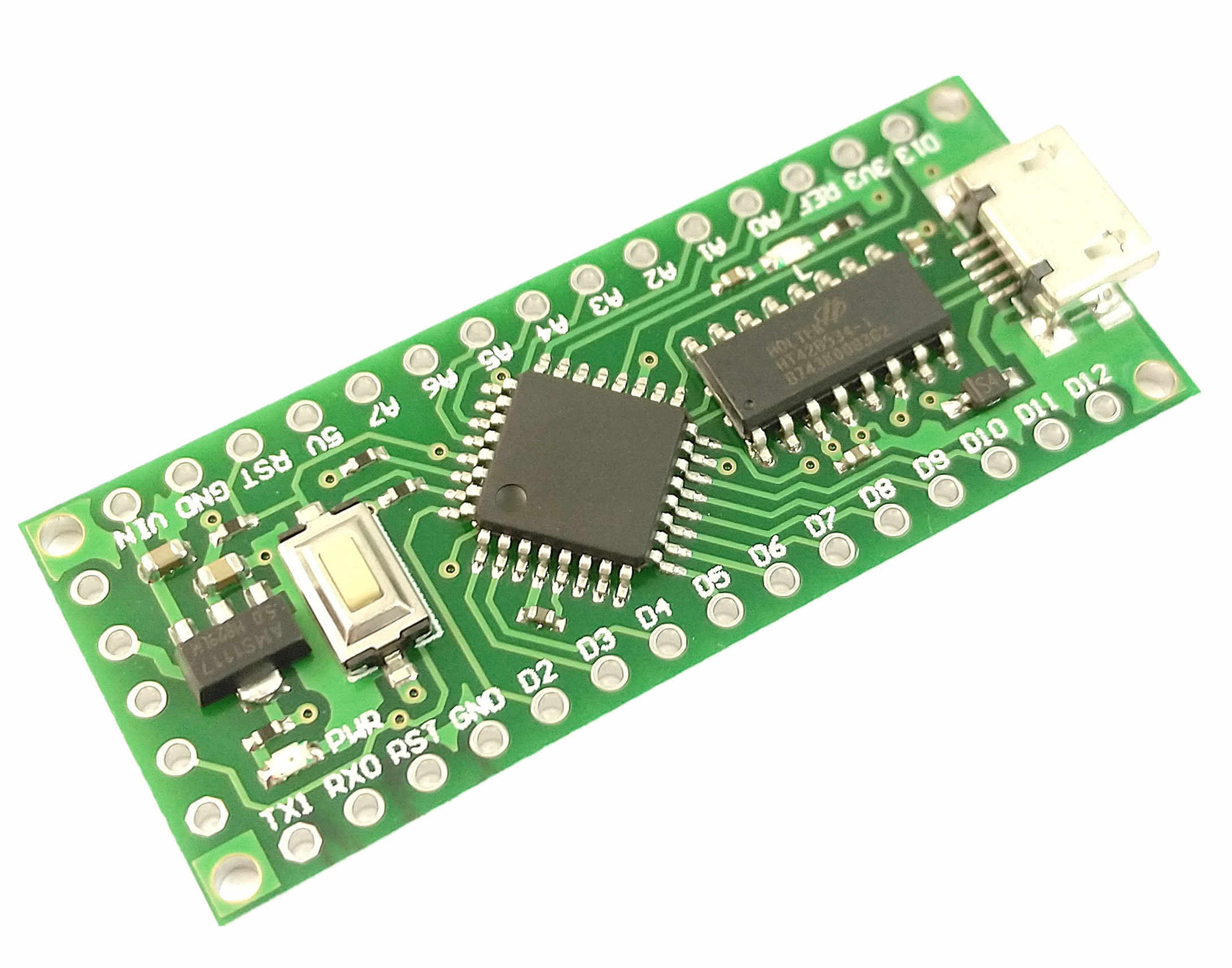LGT8F328P QFP32L ADC 12bit 4096 [9ch] (Nano8F328P 8ch)
DAC0 8bit 1ch 27 OUTPUT (Nano8F328P 25 I/O) Compatible Arduino Nano 3.0
LGT8F328P Board Features
· 8F328P-U MCU used by the LGT8F328P, is a Atmel MEGA328P compatible chip.
· LGT8F328P architecture design is relatively new, peripheral functions far stronger than Atmel MEGA328. Especially the program encryption ability is far more than MEGA328.
· LGT8F328P can use 3V3 and 5V power supply running at 16MHz frequency, excellent level compatibility.
· Built-in high-precision RC, no external crystal can be stable operation.
· Less peripheral parts, circuit design is simple.
· 12-bit ADC (analog-to-digital conversion) 8 channel
· 1 channel board DAC 8 bit
· Owned GUID (unique ID) can be used for chip program encryption
· Built-in internal 1.024V / 2.048V / 4.096V ± 1% calibratable reference voltage source
· PWM pin number: D3, D5, D6, D9, D10, D11
The feature compare
| Feature |
LGT8F328P |
atmega328P |
| DAC output |
Yes (D4) |
- |
| ADC |
12bit (9 channel) |
10bit (8 channel) |
| ADC Sampling rate Max. |
500KSPS |
15kSPS |
| Analog Comparator |
2 |
1 |
| unique ID |
Yes |
- |
| Internal reference resoltuion |
±0.5% |
±1.5% |
| PWM dead zone control |
Yes |
- |
| High current push - pull PWM |
Yes |
- |
| Computing Accelerator (DSC) |
Yes |
- |
| Stacking expansion system |
Yes |
- |
| Speed |
32Mhz |
16Mhz |
| OUTPUT |
27 pin |
20 pin |
| INPUT |
30 pin |
23pin |
Parameters
| MCU |
LGT8F328P Nano pinout |
| FLASH |
32Kbytes |
| SRAM |
2Kbytes |
| E2PROM |
0K/1K/2K/4K/8K(FLASH Share) |
| PWM |
8 |
| Frequency |
16MHz(Maximum 32MHz) |
| ADC |
8-channel 12-bit high-speed ADC |
| DAC |
8-bit programmable DAC |
| UART |
1 |
| SPI |
YES |
| TWI(I2C) |
YES |
| GUID |
YES |
| Internal Vref |
1.024V/2.048V/4.096V ±0.5% |
| System logic level |
5V |
https://github.com/LGTMCU/Larduino_HSP
https://www.holtek.com/productdetail/-/vg/42B534-x.
*
https://www.holtek.com/productdetail/-/vg/42B534-x.*https://github.com/RalphBacon/LGT8F328P-Arduino-Clone-Chip-ATMega328P
https://github.com/LGTMCU/Larduino_HSP
https://www.holtek.com/productdetail/-/vg/42B534-x.
https://github.com/RalphBacon/LGT8F328P-Arduino-Clone-Chip-ATMega328P
LGT8F328P DAC0
// The LGT8F328P has an 8-bit DAC. Let's talk about how to use the DAC.
// It should be noted that the ADC and DAC use the same reference source.
// If you change the reference source, the two reference sources are changed at the same time.
//
// Output a fixed voltage value:
//----------------------------
int dac = 4; //Define dac pin
void setup() {
// pinMode(DAC0, ANALOG); //Initialize the dac pin to analog output mode
pinMode(dac, ANALOG); //Initialize the dac pin to analog output mode
analogReference(INTERNAL2V048); //Set the reference source to 2.048 internal reference
}
void loop() {
analogWrite(dac, 100); // DAC is 8-bit precision and the range is 0-255. 255 is the reference source upper limit.
}
LGT8F328P DAC Sinewave
//--------------------------
// Output sine wave
#define PI 3.1415926535897932384626433832795 //Define the constant π
void setup() {
pinMode(4, ANALOG); //Configure the DAC output
analogReference(INTERNAL4V096); //Internal reference source 4.096V
}
void loop()
{
for(float i=0;i<=2;i=i+0.01) //The starting point is 0, the termination is 2π, and the sampling rate is 0.01
{
float rad=PI*i;
float Sin=sin(rad);
long intSin=Sin*300; //amplify the data by 300 times, take the integer
byte val=map(intSin,-300,300,0,255); // map to 8 bits DAC precision
analogWrite(4, val); //DAC output
}
}
//----------------------------------
LGT8F328P (QFP32L) TEST
I/O D20/D21/D22/D23/D26 (output mode)
/*
LGT8F328P QFP32L
TEST OUTPUT mode
LG8F328P | Arduino PIN
PE0/SWC | D22
PE1/ADC6 | D20
PE6/AVERF| D26
PE2/SWD | D23
PE3/ADC7 | D21
*/
// the setup function runs once when you press reset or power the board
#define LED_BUILTIN D13
void setup() {
// initialize digital pin LED_BUILTIN as an output.
pinMode(LED_BUILTIN, OUTPUT); // PB5 | D13
pinMode(D20, OUTPUT); // PE1/ADC6 | D20
pinMode(D21, OUTPUT); // PE3/ADC7 | D21
pinMode(D22, OUTPUT); // PE0/SWC | D22
pinMode(D23, OUTPUT); // PE2/SWD | D23
pinMode(D26, OUTPUT); // PE6/AVERF| D26
}
// the loop function runs over and over again forever
void loop() {
digitalWrite(LED_BUILTIN, HIGH); // turn the LED on (HIGH is the voltage level)
digitalWrite(D20, HIGH);
digitalWrite(D21, HIGH);
digitalWrite(D22, HIGH);
digitalWrite(D23, HIGH);
digitalWrite(D26, HIGH);
delay(1000); // wait for a second
digitalWrite(LED_BUILTIN, LOW); // turn the LED off by making the voltage LOW
digitalWrite(D20, LOW);
digitalWrite(D21, LOW);
digitalWrite(D22, LOW);
digitalWrite(D23, LOW);
digitalWrite(D26, LOW);
delay(1000); // wait for a second
}

LGT8F328P (QFP32L) uses the unique ID
// Traditional Arduino UNO, NANO, Pro Mini have no unique ID, if you do something that needs to be
// encrypted. . . . With the core design of AVR MEGA328, Huaqiang North has a very low cost. . .
// Low enough you can't imagine!
// LGT8F328P anti-crack performance is far better than MEGA328, after all, is the Chinese designed chip, crack // the big country design chip. . . The first consideration is how to prevent cracking. . . . The unique ID is a
// necessary means of software encryption.
void setup() {
Serial.begin(9600); // Initialize the serial port
Uint32_t guid = (GUID3 << 24) | (GUID2 << 16) | (GUID1 << 8) | GUID0; // Assign a unique ID to guid
Serial.print("Unique ID LGT8F328P : ");
Serial.println(guid); // Serial output unique ID
}
void loop()
{
}




*
![LGT8F328P (ADC 12bit [8ch] / DAC 8bit [1ch] 30 I/O) Compatible Arduino nano 3.0](https://co.lnwfile.com/_/co/_raw/s8/gs/nl.jpg)







